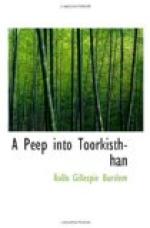It may be as well to remark here, that in these valleys as throughout Affghanist[=a]n in general, the forts are made of mud, the walls being of great strength and thickness; they are built gradually, and it takes many months to erect a wall twenty feet high, as each layer of mud is allowed to bake and harden in the sun before the next is superimposed. Now, as none of the chiefs possess cannon, except the Meer Walli and Moorad Beg of Koondooz, it is almost impossible to gain an entry into a well-constructed fort, except by treachery; and even the few honey-combed pieces of small calibre possessed by the above chieftains would not have much effect against the massive ramparts.
But the Uzbegs have a method of undermining the bastion, by turning the course of some convenient stream right under the very base; this gradually softens the lower stratum of mud, and diminishing its tenacity, the whole fabric comes tumbling down from its own weight. They also have frequently recourse to mining, but for either method to succeed the defenders cannot be on the alert.
A man who had been engaged in an operation of the latter kind, by which the fort of Badjgh[=a]r was once taken, explained to me the plan adopted, which bears a rude analogy to the modern plan of mining under the glacis to the foot of the counterscarp.
To-day a horseman came into our camp at about 3 P.M. with letters from Bamee[=a]n; he had left early in the morning, and thus accomplished a journey of fifty miles with the same horse, over two severe passes, and through a succession of difficult defiles. On alighting, he tied his horse to the branch of a tree, merely loosening the girths, but not intending to give him food till the evening. The horses are habituated to the want of any midday feeding, and at night and morning seldom get grain. But the dried lucerne and other artificial grasses with which they are supplied must afford them sufficient nourishment, as they are generally in very good working condition; they are undersized, but very sure-footed; it is indeed astonishing over what fearful ground they will carry their riders. The yabboo is a different style of animal, heavier built and slower; its pace is an amble, by means of which it will get over an immense distance, but it is not so sure-footed.
I remarked that aged horses were very rarely met with, and on inquiring the reason, was informed that the horses were all so violently worked when young as soon to break down, after which they are slaughtered and made into kabobs. I was assured that the eating-shops of Cabul and Kandah[=a]r always require a great supply of horseflesh, which is much liked by the natives, and when well seasoned with spices is not to be distinguished from other animal food.




